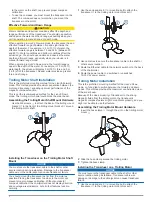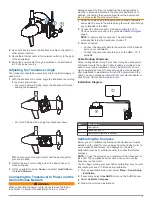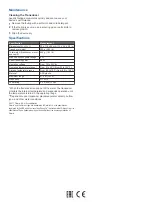
to the motor on the shaft, can prevent proper compass
calibration.
• To use the compass, you must mount the transducer on the
shaft. The compass does not work when you mount the
transducer on the motor.
Effective Forward and Down Range
CAUTION
Water conditions and bottom conditions affect the depth and
range performance of the transducer. You should use caution
and observe the water depth and range, especially when your
unit is operating in manual range or depth mode.
When operating in LiveVü Forward mode, the transducer has an
effective forward range of between five and eight times the
depth of the water. For example, in 3 m (10 ft.) of water, the
effective forward range is between 15 and 24 m (between 50
and 80 ft.). Water conditions and bottom conditions affect the
actual range. You should use caution and observe the water
depth and forward range, especially when your device is in
manual forward range mode.
When operating in LiveVü Down mode, the fore/aft range is
equal to the depth of the water. For example, in 10 m (33 ft.)
water depth, the screen will display 5 m (16 ft.) fore and 5 m
(16 ft.) aft of the transducer. Deeper water provides a greater
fore and aft range.
Trolling Motor Shaft Installation
This is the preferred mounting method for the LiveVü Forward
mode. This method provides maximum separation between the
motor and transducer, enabling optimum performance of the
magnetic compass function.
This is not the recommended method for the LiveVü Down
mode. The trolling motor barrel could block the sonar beam.
Assembling the Trolling Motor Shaft Mount Hardware
Use the M6 screws
À
to attach the back of the trolling mount
bracket
Á
to the front of the trolling mount bracket
Â
around
the trolling motor shaft.
Installing the Transducer on the Trolling Motor Shaft
Mount
NOTICE
You must secure the transducer cable to the shaft or other
secure location during installation. Damage to the transducer
cable wire or the cable jacket can cause transducer failure.
You should mount the transducer as far from the motor as
possible. Placing the transducer too close to the motor can
prevent proper compass calibration. Without successful
compass calibration, the chartplotter does not display direction
and coverage area indicators, but all other features function
normally.
1
Use the enclosed knob
À
or mounting bolt to attach the
transducer
Á
to the trolling motor mount bracket
Â
.
2
Use cable ties to secure the transducer cable to the shaft or
other secure location.
3
Route the Ethernet cable to the network switch or to the back
of the chartplotter.
4
Route the power cable to a switched or unswitched
10-35 Vdc power source.
Trolling Motor Installation
This is the preferred mounting method for the LiveVü Down
mode, or if you plan to switch between the forward and down
modes. This method provides the maximum unobstructed view
of the sonar beam.
Because of the close proximity of transducer to the strong
magnetic fields from the trolling motor, the transducer's
magnetic compass feature might not calibrate properly, and you
might not be able to use that feature.
Assembling the Trolling Motor Mount Hardware
1
Insert the hose clamp
À
through the slot on the trolling motor
mount
Á
.
2
Slide the hose clamp around the trolling motor.
3
Tighten the hose clamp.
Installing the Transducer on a Trolling Motor
NOTICE
You must secure the transducer cable to the shaft or other
secure location during installation. Transducer cable wire
damage or damage to the cable jacket can cause transducer
failure.
1
Use the enclosed knob
À
or mounting bolt to attach the
transducer
Á
to the trolling motor mount bracket
Â
.
2








